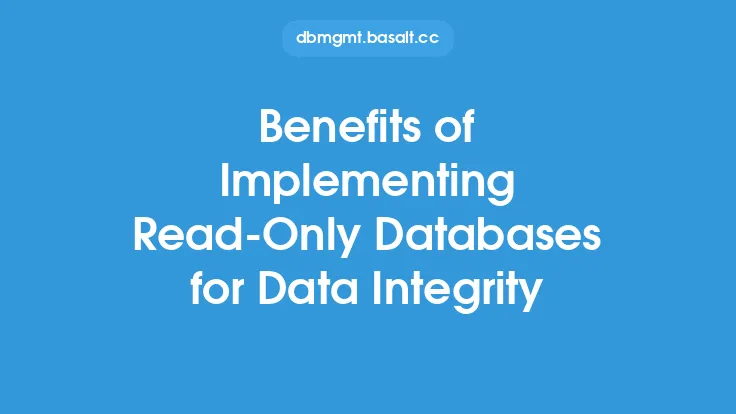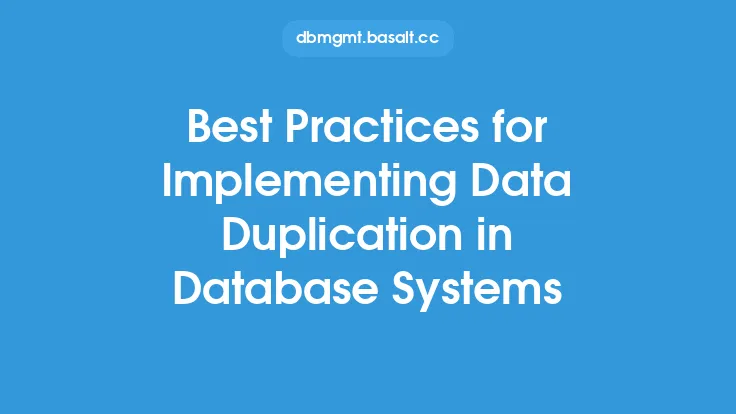Implementing data redundancy is a crucial aspect of data denormalization, which involves intentionally duplicating data to improve data recovery and availability. This approach can be particularly useful in systems where data loss or corruption can have significant consequences. By implementing data redundancy, organizations can ensure that their data is protected and can be quickly recovered in the event of a disaster or system failure.
Introduction to Data Redundancy
Data redundancy involves duplicating data across multiple locations, such as servers, storage devices, or databases. This duplication can be done at various levels, including at the bit level, block level, or file level. The goal of data redundancy is to ensure that data is available and can be recovered quickly, even if one or more copies of the data are lost or corrupted. Data redundancy can be implemented using various techniques, including mirroring, replication, and erasure coding.
Types of Data Redundancy
There are several types of data redundancy, each with its own strengths and weaknesses. Mirroring involves duplicating data in real-time, so that two or more copies of the data are always available. Replication involves duplicating data at regular intervals, such as every hour or every day. Erasure coding involves breaking data into smaller pieces and storing them across multiple locations, so that the data can be recovered even if some of the pieces are lost or corrupted. Each of these techniques has its own advantages and disadvantages, and the choice of which one to use will depend on the specific needs of the organization.
Implementing Data Redundancy
Implementing data redundancy requires careful planning and execution. The first step is to determine which data needs to be redundant, and how much redundancy is required. This will depend on the specific needs of the organization, as well as the level of risk associated with data loss or corruption. Once the data to be redundant has been identified, the next step is to choose a redundancy technique, such as mirroring or replication. The chosen technique will depend on the specific needs of the organization, as well as the resources available.
Data Redundancy Techniques
There are several data redundancy techniques that can be used to implement data redundancy. Mirroring involves duplicating data in real-time, so that two or more copies of the data are always available. This technique is often used for critical data, such as financial transactions or customer information. Replication involves duplicating data at regular intervals, such as every hour or every day. This technique is often used for less critical data, such as backups or archives. Erasure coding involves breaking data into smaller pieces and storing them across multiple locations, so that the data can be recovered even if some of the pieces are lost or corrupted. This technique is often used for large amounts of data, such as video or audio files.
Benefits of Data Redundancy
Data redundancy has several benefits, including improved data availability and recoverability. By duplicating data across multiple locations, organizations can ensure that their data is always available, even if one or more copies of the data are lost or corrupted. Data redundancy can also improve data recoverability, by providing multiple copies of the data that can be used to recover from a disaster or system failure. Additionally, data redundancy can improve system performance, by allowing data to be accessed from multiple locations.
Challenges of Data Redundancy
While data redundancy has several benefits, it also has several challenges. One of the main challenges is the increased storage requirements, as duplicate copies of the data must be stored. This can be particularly challenging for large amounts of data, such as video or audio files. Another challenge is the increased complexity, as data redundancy requires careful planning and execution to ensure that the data is properly duplicated and recovered. Additionally, data redundancy can be expensive, as it requires additional storage and hardware to implement.
Best Practices for Implementing Data Redundancy
To implement data redundancy effectively, organizations should follow several best practices. First, they should identify which data needs to be redundant, and how much redundancy is required. This will depend on the specific needs of the organization, as well as the level of risk associated with data loss or corruption. Next, they should choose a redundancy technique, such as mirroring or replication, based on the specific needs of the organization. They should also ensure that the data is properly duplicated and recovered, and that the redundancy system is regularly tested and maintained.
Conclusion
Implementing data redundancy is a crucial aspect of data denormalization, which involves intentionally duplicating data to improve data recovery and availability. By implementing data redundancy, organizations can ensure that their data is protected and can be quickly recovered in the event of a disaster or system failure. While data redundancy has several benefits, it also has several challenges, including increased storage requirements, complexity, and cost. To implement data redundancy effectively, organizations should follow several best practices, including identifying which data needs to be redundant, choosing a redundancy technique, and ensuring that the data is properly duplicated and recovered. By following these best practices, organizations can ensure that their data is always available and can be quickly recovered, even in the event of a disaster or system failure.





